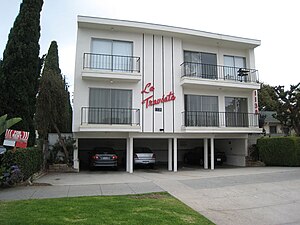This article may be unbalanced toward certain viewpoints. (September 2020) |

A dingbat is a type of apartment building that flourished in the Sun Belt region of the United States in the 1950s and 1960s, a vernacular variation of shoebox style "stucco boxes". Dingbats are boxy, two or three-story apartment houses with overhangs sheltering street-front parking.[1] They remain widely in use today as “bastions of affordable shelter.”[2] The dingbat, like the bungalow court, was a "popular and populist form of housing."[3]
Mainly found in Southern California, but also in Arizona, Florida, Hawaii, Nevada, and Vancouver, Canada, dingbats vary in cost from inexpensive to high-end. Some replaced more distinctive but less profitable building structures, such as single-family Victorian homes.[4] Since the 1950s they have been the subject of aesthetic interest as examples of Mid-Century modern design and kitsch, since many dingbats have themed names and specialized trim.
From a structural engineering perspective, the "tuck-under parking" arrangement may create a soft story if the residential levels are supported on slender columns without many shear walls in the parking level.[5] Soft story buildings can collapse during an earthquake.
- ^ Pitt, Leonard and Dale Pitt (1997). Los Angeles A to Z: An Encyclopedia of the City and County. Berkeley: University of California Press. pp. 110–111. ISBN 0-520-20274-0.
- ^ Bliss, Laura (2021-09-24). "Dingbats: The Iconic Affordable Homes for L.A. Dreamers". Bloomberg.com. Retrieved 2022-07-23.
- ^ Kaplan, Sam Hall (1987). L.A. Lost & Found. Crown Publishers, Inc. p. 142. ISBN 0-517-56184-0.
- ^ Deegan, Joe (March 16, 2006), Dingbat Eyesores, Loving Eye, San Diego Reader
- ^ William Graf (May 2008), "The ShakeOut Scenario, Supplemental Study: Woodframe Buildings Archived 2016-01-09 at the Wayback Machine," U.S. Geological Survey Circular 1324, p. 12.
